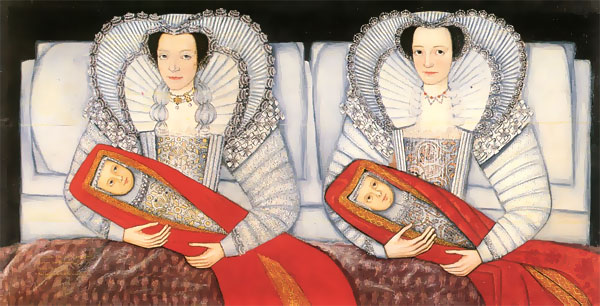Childbirth is openly discussed in today's society. Images of pregnant women appear in magazines and women giving birth can be seen on television and in movies. Yet during the medieval period, childbirth was deemed a private affair. Giving birth in the middle ages was a dangerous time for women and childbirth did not discriminate. Young mothers, older mothers, poor or rich mothers, all could die not only in childbirth but also due to complications afterwards. Sadly, more than one in three women died during their child-bearing years.
Initially, some women would not have even known they were pregnant until they felt the first movement of their baby inside of them at around five months. This was known as the "quickening". It seems amazing to us that a woman would not know that she was pregnant for several months, but there were no reliable tests for pregnancy during the Tudor period. A woman may have turned to a doctor to see if she was pregnant, but the tests were far from reliable. One pregnancy test during the Tudor period was to examine the colour of the urine and if it was a pale yellow to white colour with a cloudy surface the woman may have been pregnant. Other tests involved examining a needle left in the woman's urine to see if it rusted, or seeing what happened when wine was mixed with the woman's urine. Also a women's lack of regular menstruation could be related to several factors including illness, breast-feeding, excessive fasting or even a poor diet.
There was no way of monitoring the baby's heart rate or to take blood pressures, and thus women replied heavily upon other experienced women to support and help them. Childbirth was predominantly women's business and physicians and doctors only attended under the most extreme circumstances, such as in Queen Jane Seymour's case when she was giving birth to the future king and had problems. More commonly if a woman had the funds or contacts she would have sought advice and support from a midwife, a woman who had a great deal of experience and knowledge in delivering babies.
There are very few accounts of what giving birth was like for the common, every-day Tudor woman, as not only was it a private affair but women generally did not write down or record their lives. However, if a queen gave birth, well that was a public matter as she could be giving birth to the next heir. Therefore we can turn to the pregnancies and births of royal women to see what giving birth might have been like for some women during the Tudor period.
Women of noble birth, such as the queen or of higher classes, would close themselves off from the world for a period before they gave birth. This was commonly known as 'lying in' or 'taking her chamber'. Before this, an elaborate service was held where the Church would ask God for his blessing for the birth. After the service and the prayers from the clergy, the queen went into her private rooms. The common woman may have gone to church or sought the blessing from the Priest before she too removed herself from the public eye for her own lying in. Other women, sadly those of the much lower class, may have had to work right up until they went into labour as there was no one to cover their daily responsibilities.
--
Proprietress of Tatiana's Tea Room ~ Owner of the Provence Coeur Estate ~ Webmistress of this site
updated by @tatiana-dokuchic: 05 Jan 2017 06:45:54PM



